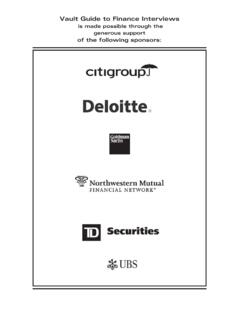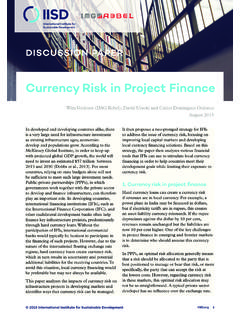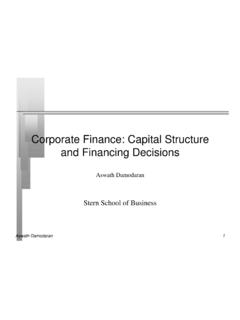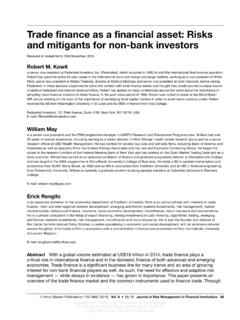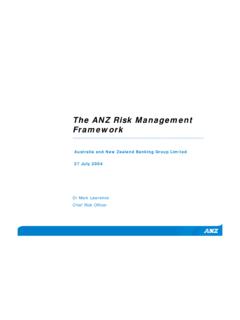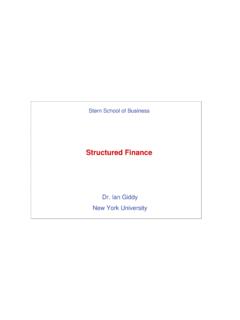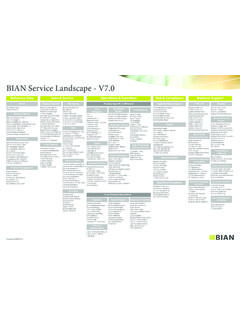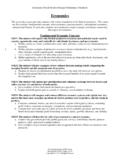Transcription of International Finance: Putting Theory Into Practice
1 International Finance: Putting Theory Into PracticePiet SercuLeuven School of Business and EconomicsKatholieke Universiteit Leuven14:20 on 2 July 2008 PrefaceAbout this bookThis book had a forerunner International Financial Markets and The Firm , co-authored with Raman Uppal, which came out in 1995. By 2003 or 2004 Raman andI had agreed that a text full of Italian Lira or German Marks and where tradersstill had a full two minutes to respond to market makers quotes, might sooner orlater risk getting outdated. Starting the revision itself turned out to be much moredifficult than agreeing on the principle, though. In the end Raman, being so muchbusier and more rational than I am, preferred to bow out. How right he was. Still,now that the effort has become a sunk cost, forever bygone, I find that episodeswhere I sincerely curse the book (and myself and Princeton University Press) arebecoming fewer and farther between.
2 Actually, there now are several passages Iactually begin to the previous book, the book still targets finance students, or at least studentsthat want a genuine finance text, not an International -management or -strategy textwith a finance slant nor an International monetary economics text with some cor-porate applications. There is a continued bias in favor of financial markets andeconomic logic; the aim is to provide students with a coherent picture of interna-tional markets and selected topics in multinational corporate finance . Sure, duringeveryday Practice later on, this framework will then get amended and corrected andqualified; but the feeling of fundamental coherence will remain, we book is more analytical than the modal text in the field. Compared to theSercu-Uppal book, some of the math has been dropped and new matter has beenadded.
3 As before, a lot of it is in Appendices, thus stressing its optional main difference, I think, is that the in-text math is brought in in International Financial Markets we had every theorem or proof followedby an example, now the example comes first whenever that is possible. If so, theproof is often even omitted, or turned into a DoItYourself assignment. In fact, athird innovation is that, at least in the chapters or sections that are sufficientlyanalytical rather than just factual, the reader is invited to prove or verify claimsand solve analogous problems. The required level of math is surely not prohibitive;anybody who has finished a good finance course should be able to master theseDoItYourself assignments. Still, while the required level of mathematical prowess isiiiivlow, a capacity for abstract thinking and handling symbols remains Part, except the Intro one, now has its own introductory case, which isintended to stimulate the reader s appetite and which can be a source of cases usually cover issues from most chapters in the fifth change is that the Part on exchange-rate pricing is much reduced.
4 Theformer three Chapters on exchange-rate theories, predictability, and forward bias arenow shrunk to two. And, lastly, three wholly new chapters have been added: two oninternational stock markets especially crosslisting with the associated corporate-governance issues and one on Value at , a preface like this one continues with a discussion and motivation ofthe book s content. But my feeling is that most readers and surely students skip prefaces anyway. Since the motivation of the structure is quite relevant, thatmaterial is now merged into the general introduction chapter, Chapter to use this bookThe text contains material for about two courses. One possibility is to take thesecond Part, International Financial Markets, as one course, and group the morebusiness- finance oriented material (grouped intoExchange Risk, Exposure, and RiskManagement(III) andLong-Term Financing and Investments(IV)) as a markets, which now is in Part III, could be included in the mar-kets/instruments course, like it was in the 1995 book; and the whole package canalso duplicate as an intro derivatives course, along with the apocryphal Chapter?
5 ?that is available on my website. I myself run two 40-hr courses covering, respectivelyParts II-III (Instruments, Risk Management) and Part IV (Stocks, bonds, capitalbudgeting).For one single course one could focus, in Part II, on spot (Chapter 3) and forwards(Chapters 4 and 5), and then continue with the chapters on relevance of hedgingand exposure (Chapters 12 and 13), to finish with capital budgeting (Chapter 21);this shortlist can be complemented by a few chapters of your , December P. Sercu, Free copying stops Oct 1st, 08 Formatted 2 July 2008 14 the authorPiet Sercu is Professor of International finance at theKatholieke Universiteit Leu-ven. He holds the degrees of Business Engineer, Master of Business Administration,and Doctor in Applied Economics from Leuven. He taught at the FlemishBusiness School in Brussels (1980-1986), prior to returning to Leuven, where hecurrently teaches the International Business finance courses in the Masters andAdvanced Masters programs.
6 He also held Visiting Professor appointments at NewYork University, Cornell University, the University of British Columbia, the Lon-don Business School, andUniversit e Libre de Bruxelles. He taught shorter financecourses in Helsinki, Bandung (Indonesia), Leningrad, and India (as anUNDPex-pert and, in 1994, as a fellow of the European Indian Cooperation and ExchangeProgramme), and regularly teaches executive courses. He held the 1996/7 Franc-qui Chair at theFacult es Universitaires Notre-Dame de la Paixat Namur, and the2000/04 PricewaterhouseCoopers Chair on Value and Risk atKULeuven, togetherwith Marleen Willekens. Until 2000, he organized and taught doctoral courses inthe European Doctoral Education Network, as part of the finance faculty of theEuropean Institute for Advanced Studies in Management.
7 He was the 1994 Vice-President and 1995 President of the European finance Association, won the 1999 Western finance Association award for Corporate finance (with Xueping Wu andCharley Park) and was Hanken Fellow in early research focused on International Asset Pricing with real exchange riskand inflation risk. He also did some work on corporate take-over models and lendingbut has recently returned to International finance and hedging. He has publishedin the Journal of finance , Journal of Banking and finance , Journal of InternationalMoney and finance , European Economic Review, and other journals. He is on theeditorial boards of the European Financial Management Journal and the Journalfor International Financial Markets, Institutions and Sercu and Raman Uppal jointly won the 1995 Sanwa Prize for a monographin International finance ,Exchange Rate Volatility, Trade, and Capital Flows underAlternative Currency Regimes, published by Cambridge University Press in 2000and 2006.
8 They also have producedInternational Financial Markets and The Firm( International Thomson Publishers, Cincinnati-London, 1995), the forerunner tothis book and the source of much of its material. There are also a number of jointacademic are many individuals who played an important role in the production ofthis book. First and foremost I thank Raman Uppal, not only for his invaluablecontribution to the first book but also for the discussions about how to structurea new version, for translating the text parts of the old manuscript into LaTeX,and setting up a master file system to produce the whole. Thanks also to theformer and current doctoral students or assistants who read earlier drafts of the firstand second book and suggested several improvements: Badrinath H.
9 R., Thi NgocTuan Bui, Katelijne Carbonez, C edric de Ville de Goyet, Kathy Dehoper e, MarianKane, Fang Liu, Rosanne Vanp ee, Tom Vinaimont, and Xueping Wu. Marian,especially, did lots of work on the exercises, and Katelijne on the revised Martina Vandebroek occasionally helped with spreadsheets and graphs, atwhich she Excels; she, Fang Liu and Badrinath H. R. provided the empirical resultsfor Chapters 10 and 11. Many thanks, lastly, to colleagues who read drafts andprovided comments, some of them at Princeton s request but some even of theirfree will: Hu Shengmei, Karen Lewis, Bernard Dumas, Stan Standaert, Charles vanWymeersch, and an anonymous (but wholly positive) referee reporting to PrincetonUP. Of course, I remain responsible for all remaining errors.
10 Comments and feedbackfrom readers about errors, presentation, and contents are very welcome: do dedicate this book to my parents, Jan Sercu and the late T er`ese Reynaert,and to my wife Rita and children Maarten and Jorinde, who have patiently put upwith my inattentive absent-mindedness during the time it has taken to completethis project and, come to think of it, most of the time before and 2007viiContentsI Introduction and Motivation for International Finance11 Why does the Existence of Borders Matter for finance ? Issues in International Business finance .. Risk .. of the Consumer-good Markets .. risk .. risk .. Segmentation Issues, including Aspects of Corpo-rate Governance .. Tax Issues .. is on the InternationalCFO s desk? .. and, more Generally, Risk Management.
